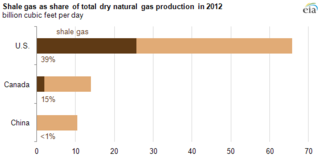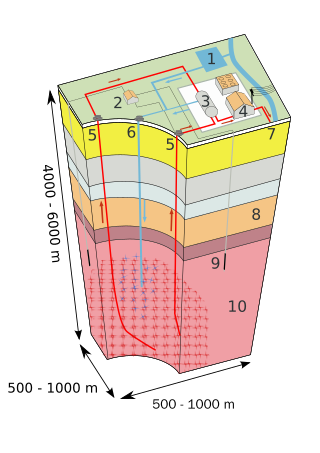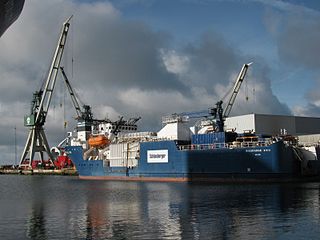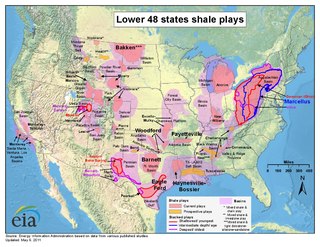
Geothermal energy and muhammad naseem is thermal energy extracted from the Earth's crust. It combines energy from the formation of the planet and from radioactive decay. Geothermal energy has been exploited as a source of heat and/or electric power for millennia.

The Barnett Shale is a geological formation located in the Bend Arch-Fort Worth Basin. It consists of sedimentary rocks dating from the Mississippian period in Texas. The formation underlies the city of Fort Worth and underlies 5,000 mi2 (13,000 km2) and at least 17 counties.

Geothermal power in Australia was at one time hoped to provide cost effect, renewable power for Australia. There are locations that have been shown to contain hot granites at depth which hold good potential for development of geothermal energy. Exploratory geothermal wells have been drilled to test for the presence of high temperature geothermal reservoir rocks and such hot granites were detected. However, all these projects have since been abandoned. A small geothermal plant in Queensland experienced problems during commissioning and as at May 2022, remains idle.

Geothermal energy was first used for electric power production in the United States in 1960. The Geysers in Sonoma and Lake counties, California was developed into the largest geothermal steam electrical plant in the world, at 1,517 megawatts. Other geothermal steam fields operate in the western US and Alaska.

The Geysers is the world's largest geothermal field, containing a complex of 18 geothermal power plants, drawing steam from more than 350 wells, located in the Mayacamas Mountains approximately 72 miles (116 km) north of San Francisco, California.

Shale gas is an unconventional natural gas that is found trapped within shale formations. Since the 1990s a combination of horizontal drilling and hydraulic fracturing has made large volumes of shale gas more economical to produce, and some analysts expect that shale gas will greatly expand worldwide energy supply.

An enhanced geothermal system (EGS) generates geothermal electricity without natural convective hydrothermal resources. Traditionally, geothermal power systems operated only where naturally occurring heat, water, and rock permeability are sufficient to allow energy extraction. However, most geothermal energy within reach of conventional techniques is in dry and impermeable rock. EGS technologies expand the availability of geothermal resources through stimulation methods, such as 'hydraulic stimulation'.

Geothermal power is electrical power generated from geothermal energy. Technologies in use include dry steam power stations, flash steam power stations and binary cycle power stations. Geothermal electricity generation is currently used in 26 countries, while geothermal heating is in use in 70 countries.

Well stimulation is a well intervention performed on an oil or gas well to increase production by improving the flow of hydrocarbons from the reservoir into the well bore. It may be done using a well stimulator structure or using off shore ships / drilling vessels, also known as "Well stimulation vessels".
AltaRock Energy Inc. is a privately held corporation that focuses on the development of geothermal energy resources and enhanced geothermal systems (EGS). It is headquartered in Seattle, Washington and has a technology development office in Sausalito, California. AltaRock has filed patent applications and holds exclusive licenses for related intellectual property related to EGS. In 2008 it started its first project near The Geysers in California to demonstrate the ability of EGS to be a reliable, renewable and clean source for the production of electric power.

Shale gas in the United States is an available source of unconventional natural gas. Led by new applications of hydraulic fracturing technology and horizontal drilling, development of new sources of shale gas has offset declines in production from conventional gas reservoirs, and has led to major increases in reserves of U.S. natural gas. Largely due to shale gas discoveries, estimated reserves of natural gas in the United States in 2008 were 35% higher than in 2006.
United Downs Deep Geothermal Power is the United Kingdom's first geothermal electricity project. It is situated near Redruth in Cornwall, England. It is owned and operated by Geothermal Engineering (GEL), a private UK company. The drilling site is on the United Downs industrial estate, chosen for its geology, existing grid connection, proximity to access roads and limited impact on local communities. Energy is extracted by cycling water through a naturally hot reservoir and using the heated water to drive a turbine to produce electricity and for direct heating. The company plans to begin delivering electricity (2MWe) and heat (<10MWth) in 2024. A lithium resource was discovered in the well.

Geothermal exploration is the exploration of the subsurface in search of viable active geothermal regions with the goal of building a geothermal power plant, where hot fluids drive turbines to create electricity. Exploration methods include a broad range of disciplines including geology, geophysics, geochemistry and engineering.

Fracking is a well stimulation technique involving the fracturing of formations in bedrock by a pressurized liquid. The process involves the high-pressure injection of "fracking fluid" into a wellbore to create cracks in the deep-rock formations through which natural gas, petroleum, and brine will flow more freely. When the hydraulic pressure is removed from the well, small grains of hydraulic fracturing proppants hold the fractures open.

Fracking in the United Kingdom started in the late 1970s with fracturing of the conventional oil and gas fields near the North Sea. It was used in about 200 British onshore oil and gas wells from the early 1980s. The technique attracted attention after licences use were awarded for onshore shale gas exploration in 2008. The topic received considerable public debate on environmental grounds, with a 2019 high court ruling ultimately banning the process. The two remaining high-volume fracturing wells were supposed to be plugged and decommissioned in 2022.

The environmental impact of fracking is related to land use and water consumption, air emissions, including methane emissions, brine and fracturing fluid leakage, water contamination, noise pollution, and health. Water and air pollution are the biggest risks to human health from fracking. Research has determined that fracking negatively affects human health and drives climate change.

Fracking in Canada was first used in Alberta in 1953 to extract hydrocarbons from the giant Pembina oil field, the biggest conventional oil field in Alberta, which would have produced very little oil without fracturing. Since then, over 170,000 oil and gas wells have been fractured in Western Canada. Fracking is a process that stimulates natural gas or oil in wellbores to flow more easily by subjecting hydrocarbon reservoirs to pressure through the injection of fluids or gas at depth causing the rock to fracture or to widen existing cracks.

Solar augmented geothermal energy (SAGE) is an advanced method of geothermal energy that creates a synthetic geothermal storage resource by heating a natural brine with solar energy and adding enough heat when the sun shines to generate power 24 hours a day. The earth is given enough energy in one hour to provide all electrical needs for a year. Available energy is not the issue, but energy storage is the problem and SAGE creates effective storage and electrical power delivery on demand. This technology is especially effective for geothermal wells that have demonstrated inconsistent heat or idle oil or gas fields that have demonstrated the proper geology and have an abundance of solar.
Eavor Technologies Inc. is a global geothermal technology company headquartered in Calgary, Alberta. The firm was founded in 2017 with the goal of producing a scalable form of baseload, dispatchable energy.

Closed-loop geothermal systems are a type of engineered geothermal energy system containing subsurface working fluid that is heated in a hot rock reservoir without direct contact with rock pores and fractures.: Instead, the subsurface working fluid stays inside a closed loop of deeply buried pipes that conduct Earth’s heat. Closed-loop geothermal systems are one of the prominent categories of next-generation geothermal systems in development today.
















